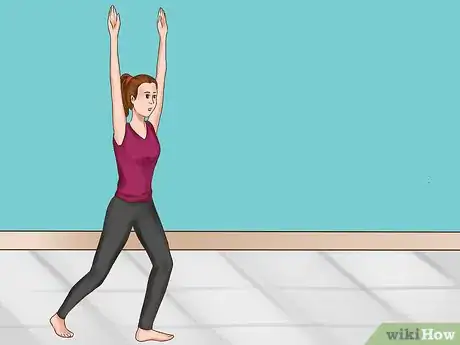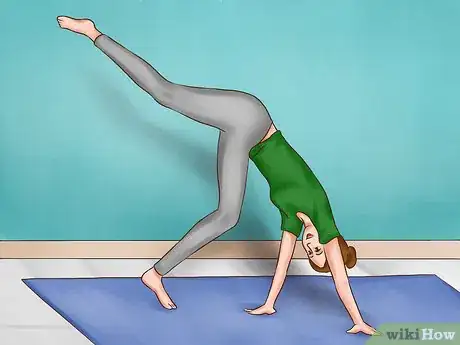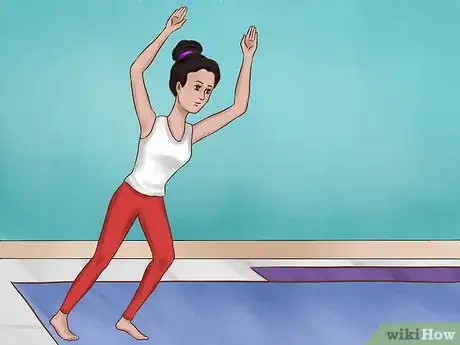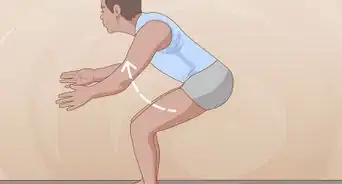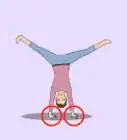wikiHow is a “wiki,” similar to Wikipedia, which means that many of our articles are co-written by multiple authors. To create this article, 25 people, some anonymous, worked to edit and improve it over time.
wikiHow marks an article as reader-approved once it receives enough positive feedback. In this case, several readers have written to tell us that this article was helpful to them, earning it our reader-approved status.
This article has been viewed 80,936 times.
Learn more...
Although it looks impressive, doing a cartwheel is in fact a very basic gymnastic move. Our bodies are well-suited to the motion involved in a cartwheel, which makes it easy for most of us to learn how to do one. For many people, though, one thing that gets in the way of learning how to do a cartwheel is the fear of falling, injury, and/or embarrassment. Although other guides provide great information on how to do a cartwheel (such as this one), here are several steps you can take to help conquer that fear.
Steps
Learning about Cartwheels
-
1Acknowledge your fear of cartwheels. Ask yourself what specifically you are afraid of. Balancing on just your hands? Being upside down? Falling? Hurting yourself?
- Define the parameters of the fear. When did you first start experiencing this fear? Did you fall? Did you have an injury? Does this fear affect other aspects of your life? This is helpful to figure out whether this is a specific fear just to cartwheels or one that is related to other activities. For example, sometimes people who are fearful of cartwheeling also don't like to flip over monkey bars or do a somersault.
- Often we fear the unknown. But think logically: how can you be afraid of something you haven't done yet, like a cartwheel? How do you know you'll fall or hurt yourself? You don't!
-
2Understand the activity. Do some research and discover what a cartwheel is and the motions involved in doing one. Knowing exactly what a cartwheel is and the steps involved can put your mind at ease.Advertisement
-
3Watch videos of people doing cartwheels. Seeing others do cartwheels successfully will give you a sense of the actual motions involved in doing one, which may help assuage your fear. Try this video or this one. It may also help to watch a slowed down video, such as this one.
- Watching other people successfully complete cartwheels should help to familiarize you with the motions and also give you confidence in the general safety of cartwheeling; you'll see that very few people injure or hurt themselves while cartwheeling.
- You'll also see that a lot of cartwheeling has very little to do with you and a lot to do with plain and simple gravity!
Practicing Cartwheels
-
1Choose a safe area to practice on. The area where you practice cartwheeling is very important. Picking the right spot will boost your confidence and make you feel safe. For example, a lawn is a great spot.
- Choose an area where the ground or floor is flat and clean. Good spots include grassy lawns and gymnasiums with mats on the floor or built-in soft surfaces.
- Make sure the space has plenty of room to enter and exit a cartwheel (you will move more distance than you think).
- Check that there is nothing in the way that you could bump into, like furniture.
- Remember to consider who else may be in the space. On the one hand, you may not want to practice in front of other people if you feel nervous. On the other hand, it might make you feel better about practicing cartwheels if you know that there are people around who could help you if you fall.
-
2Practice the individual motions involved in a cartwheel. These are: lunge, hands down, (upside-down) straddle, finish with a lunge. Breaking down and spending some time working with each of these steps helps make the whole activity more manageable.
- Get used to the opening motion of a cartwheel by standing in the first position. Put your leading foot forward and raise your hands above your head. You have successfully completed the first part of a cartwheel!
- Rock back and forth to start feeling that momentum in your legs and torso. This momentum is what will propel you into the cartwheel.
- Try the lean-in movement of the initial stage of a cartwheel in slow motion. This will help you build in muscle memories of the basic way you will push off with your legs and put your hands down on the ground.
-
3Practice a full cartwheel. This is the scariest part because it's the part where you flip over your hands and are upside down for a split-second. However, remember that old adage "practice makes perfect." Well, it's true! Every time you do a cartwheel, the less scarier it will seem.
-
4Do a cartwheel a couple times a day until you no longer feel that fear. It may not be the best cartwheel in the world at first, but over time you'll get stronger and more confident.
Making Modifications
-
1Try different variations. If you're not ready to master a straight up-and-down cartwheel yet, make things easier for yourself by trying different versions of the cartwheel as build your confidence. It's okay to try different things if this is what keeps you practicing instead of giving up.
-
2Bring the ground closer to you. Stake several mats in your practice area to bring the ground closer to you when your hands go down in a cartwheel; your hands will plant on the mats, rather than on the ground below. Doing this will help close the gap between you and the ground and likely lessen your fear of falling while practicing.
-
3Angle your body to the ground rather than straight up and down. Try doing cartwheels in which you plant both hands and spin over the top, but you keep the front side of your body at an angle to the ground. This allows you to catch yourself on your feet more easily in the event of a mistake.
-
4Bend your legs. Do a cartwheel with your legs slightly bent at first. This allows you to make a safer landing if you misjudge your momentum or lose your balance.
-
5Take as much time as you need. Don't rush yourself into doing anything you're not ready for.
- Take a break if you feel a mental block. Fear is a powerful emotion that can take time to overcome. If you feel overwhelmed by fear, stand or sit still, calm your breath by counting to 10, or your attention on the ground beneath you. After a while, you'll feel calm again and perhaps ready to try again.[1]
- Gymnasts have reported success in overcoming mental blocks towards specific activities by taking a time out. Some have also had success in overcoming fear when they had time to casually "play" with different aspects of the skills and not really focus on them.[2]
-
6Keep up the momentum and keep practicing! It takes a lot of determination to conquer your fear of cartwheels. Don't give up! No one ever became perfect at something their first few attempts.
Community Q&A
-
QuestionCan I learn to do a cartwheel if I cannot do a handstand?
 Community AnswerYes. You do not balance on your hands for a cartwheel like you do for a handstand. When doing a cartwheel, you are only in the handstand position for a very small amount of time because momentum will carry you over to complete a cartwheel.
Community AnswerYes. You do not balance on your hands for a cartwheel like you do for a handstand. When doing a cartwheel, you are only in the handstand position for a very small amount of time because momentum will carry you over to complete a cartwheel. -
QuestionI bend my legs when I do a cartwheel. How do I get over that?
 Community AnswerStart by knowing the momentum of a cartwheel. When you're comfortable, start by locking your legs a little as you begin to rise your legs. Once you have it down, try not to not lock your legs but automatically straighten your legs.
Community AnswerStart by knowing the momentum of a cartwheel. When you're comfortable, start by locking your legs a little as you begin to rise your legs. Once you have it down, try not to not lock your legs but automatically straighten your legs. -
QuestionShould classes be taken if I have suffered from a dislocated knee?
 Community AnswerTalk to your doctor about moving forward with gymnastics about your injury.
Community AnswerTalk to your doctor about moving forward with gymnastics about your injury.
Warnings
- Remember that any physical activity can lead to injury. Even though some injuries happen by chance, many are due to improper preparation, incautious actions, or lack of attention to the surrounding environment.⧼thumbs_response⧽
- While caution is good, being overly tentative can also lead to injury. Although hesitating is a natural response to a feeling of discomfort or lack of ability, being committed to performing and landing a cartwheel is an important part of doing it successfully and staying safe.⧼thumbs_response⧽
- Try practicing with a friend or trainer, or spotter. After all, gymnasts may do perfect cartwheels, but they learned how to do it with help, guidance, and patience.⧼thumbs_response⧽




